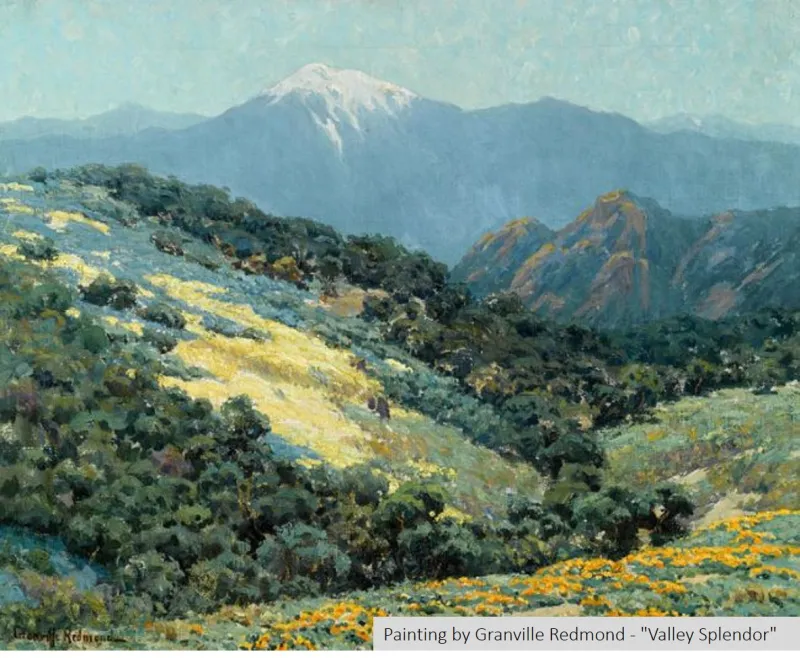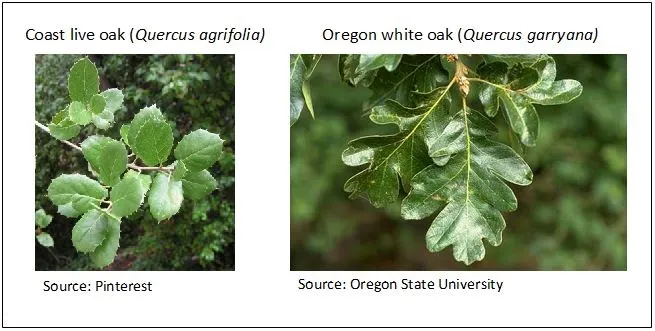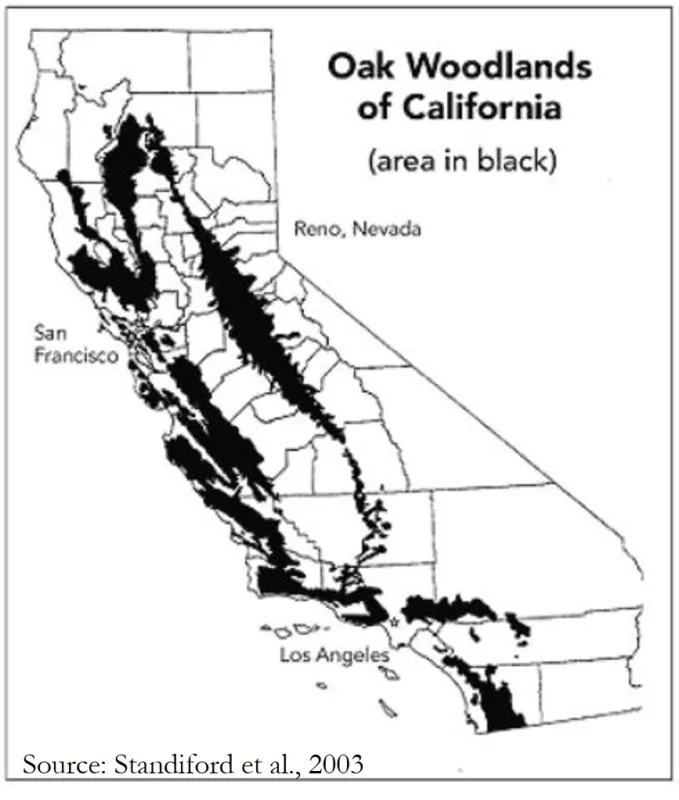Joe R. McBride, Professor Emeritus, UC Berkeley

The urban-wildland interface zone in parts of the San Francisco Bay Area supports mature oak woodlands that are dominated by either Coast live oak (Quercus agrifolia) or Oregon oak (Quercus garryana). These oak woodlands provide habitats for a number of wildlife and understory plant species. At various locations they have been harvested for firewood and grazed by livestock in the past. In pre-European settlement times they were burned by Native Americans to facilitate hunting and the collection of acorns.

Stands of oak woodland occur in the California Coast ranges, Sierra Nevada foothills, Transverse range, San Bernardino mountains, and the Peninsular ranges. The oak woodlands away from the coast are dominated by oak species other than Coast live oak and Oregon oak. These species include: Valley oak (Quercus lobata), Blue oak (Quercus douglasiana), Maul oak (Quercus chrysolepis), Interior live oak (Quercus wislizeni) and Engelmann oak (Quercus engelmannii). These oak woodlands provide considerable recreational value to the people of California as well as the habitat role they play for wildlife.

Brief History
The ecology of the Coast live oak and Oregon oak woodlands (also referred to as the Northern oak woodlands) was influenced by Native American burning in pre-settlement times and by livestock grazing during and following the Spanish colonial period. Fire and livestock grazing ceased to be significant ecological factors in oak woodlands with the establishment of parks and the growth of urban areas into the margins of oak woodlands in the twentieth century. This change resulted in the invasion of many oak woodlands by Douglas-fir (Pseudotsuga menziesii) in the San Francisco Bay Area. Both fire and livestock grazing were effective agents in eliminating Douglas-fir seedling from the understory of oak woodlands. In the absence of these factors, Douglas-fir seedling can grow up and through the oak woodland canopies and shade out the oak trees. This process has converted many oak woodlands into Douglas-fir forests. The associated change in habitat characteristics results in the loss of most of the species that depended on the oak woodland habitat. The process also creates a more hazardous fire condition because of the difference on flammability and structure of the Douglas-fir forest compared with the oak woodland.
The invasion of oak woodlands by Douglas-fir was documented in a number of studies in parks in the Bay Area. At Annadel State Park, on the east side of Santa Rosa, Barnhart et al., (1987, 1996) found significant negative correlations between Douglas-fir seedling and sapling densities and (1) the distance to seed source, (2) the cover of annual grasses, and (3) total living ground cover. They concluded that the pattern of Douglas-fir invasion will result in a reduction of biological diversity in this region of Northern California. Similar results have been found in other state parks in the North Bay (McBride and Barnhart, 2002a, 2002b, 2005).
Management Techniques
Three management techniques were proposed by Hastings et al., (1997) for the control of Douglas-fir invasion into oak woodlands. These are (1) removal of seedlings and saplings, (2) broadcast burning of oak woodland understories, and (3) girdling of Douglas-fir seed trees within oak woodland stands. These techniques have been successfully applied at Annadel, Napa-Bothe, and Jack London State Parks.
In 2015 an evaluation of the state of Douglas-fir invasion into oak woodlands at Annadel State Park was conducted (McBride, 2015). This evaluation showed a significant reduction in Douglas-fir seedlings and saplings at sites where removal of seedling and saplings had taken place. Douglas-fir seedling and sapling density also dropped where Douglas-fir tree of seed bearing age had been girdled. However, this treatment has been eliminated from the parks because of concern expressed by park visitors and the tree fall hazard of the dead Douglas-fir trees. Prescribed burning as a method for controlling Douglas-fir invasion was not included in the evaluation since no additional prescribe burns had taken place in Annadel State Park since 1994. Surveys taken in 1997 showed effective elimination of Douglas-fir seedlings by a control burn (Hastings et al., 1997).
Annotated Bibliography
1. Barnhart, S. J., McBride, J.R.; Cicero, C.; DaSilva, P.; Warner, P. 1987. Vegetation dynamics of the northern oak woodland. In: Plumb, Timothy R.; Pillsbury, Norman H., technical coordinators. Proceedings of the symposium on multiple-use management of California’s hardwood resources; November 12 - 14, 1986; San Luis Obisbo, CA. Gen. Tech. Rep. PSW - 100. Berkeley, CA: Pacific Southwest Forest and Range Experiment Station, Forest Service, U.S. Department of Agriculture; 53 -58. (link here).
This document represents a one of the initial comprehensive collection of articles that discusses in details the challenges and importance of management of oak woodlands in California. The essays presented are proceedings from the 1979 Symposium on the Ecology, Management, and Utilization of California Oaks. It provides an effective overlook on the history of management, and policies and regulations focused on native oak resources.
2. Barnhart, S. J., J. R. McBride and P. Warner. 1995. Pseudotsuga menziesii (Mirb.) Franco invasion of northern oak woodlands in the Sonoma mountains of California. Madrono 42:295-316.(link here).
This article describes the invasion of Douglas fir in oak woodland habitats observed throughout the outer North Coast Range, including the Sonoma Mountains. Invasion that resulted into a reduction of biological diversity in the region.
3. Hastings, M. S., S. Barnhart, and J. R. McBride. 1997. Restoration management of northern oak woodlands. USDA Forest Service Gen. Tech. Rep. PSW-GTR-160. (link here).
This article discusses restoration management techniques that were developed to address and mitigate the invasion of Douglas fir seedlings in oak woodlands. The articles discuses oak restoration methods applied in Annadel State Park in Sonoma County.
4. McBride, J. R. and S. Barnhard. 2002. Vegetation Management Analysis for Napa-Bothe State Park. Report to the California Department of Parks and Recreation. Sonoma, CA. 16 p. (not available in electronic form)
5. McBride, J. R. and S. Barnhart. 2002. Identification and Analysis of Vegetation Management Issues at Jack London State Park. Report to the California Department of Parks and Recreation. San Rafael, CA. 12p. (not available in electronic form)
6. McBride, J. R. and S. Barnhart. 2005. Assessment of Douglas-fir establishment in woodlands at Austin Creek State Recreation Area. Joe R. McBride and Steve Barnhart, Consulting Forest Ecologists. Berkeley, CA. 16p. (not available in electronic form).
